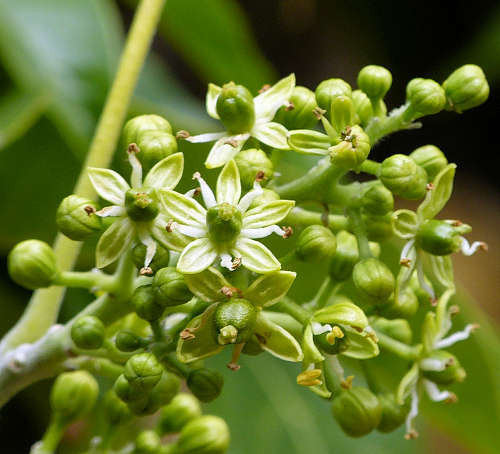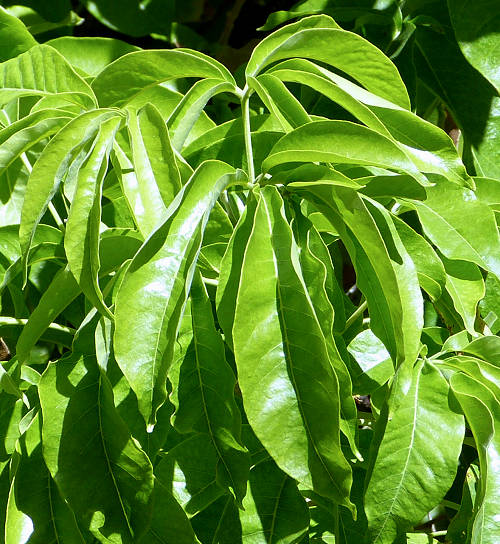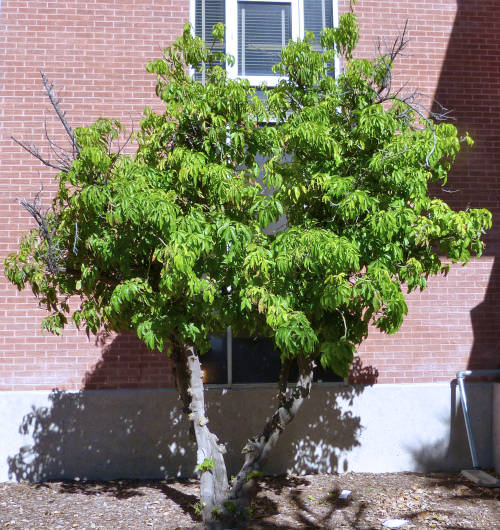Growing White Sapote:
Casimiroa edulis
Back to Fruit, Berries and Nuts
Botanical Overview
A member of the Citrus family (Rutaceae) and distantly related to cultivated
citrus, the Casimiroa genus has ten species. Of them, Casimiroa edulis, White Sapote, has
the greatest cultivation range. While many regional cultivars have been developed, only a
few are found in nurseries.
The name Sapote comes from a Nahuatl word that means soft, round, edible fruit.
White Sapote is not related to Black Sapote (Diospyros nigra) of the Ebony family, nor to
Mamey Sapote (Pouteria sapota) of the Sapodilla family.
Description
Form:
Tree.
Lifespan:
40-150 years.
Leaf retention:
This plant is evergreen, but it may drop leaves if stressed by cold or drought.
Growth rate:
Rapid, in spurts.
Mature Size:
15-50' (4.5-15m) high and as wide.
Flowers:
Five tiny, greenish-yellow petals, clustered, without fragrance. While most flowers contain
both male and female parts, some may be male only, and others may be incapable of producing
pollen.
Bloom:
Early to mid winter in regions without freezes. It may bloom several times a year. Some
cultivars bloom in alternate years.
Self-fruitful:
Yes. Cross pollination with another plant can improve fruit set.
Years before fruiting:
When grafted, 3-4; from seed, 7-8.
Fruit:
Thin green skin with white flesh, variable in shape and size, resembling an apple, containing
1-5 seeds. When fully ripe and soft, it has a custard like texture with a banana, peach, or
vanilla taste. The skin is bitter on some cultivars. While the fruit is sometimes erroneously
said to cause drowsiness, the pulp has no sedative compounds.
Months for fruit to ripen:
6-9. Fruit should be harvested when they become very slightly soft on the tree and before
they drop. Remove fruit by cutting the stems with clippers. Removing them without clipping,
or having dropped when soft, results in internal bruising leading to decay and bad tasting
pulp.
The fruit may drop off the tree early while still hard. In that case, take them inside to ripen up. They will continue to ripen after harvest, and the stem will fall off when a fruit is fully ripe. The fruit must be handled with care and are easily bruised internally, becoming bitter under the bruise.
The fruit may drop off the tree early while still hard. In that case, take them inside to ripen up. They will continue to ripen after harvest, and the stem will fall off when a fruit is fully ripe. The fruit must be handled with care and are easily bruised internally, becoming bitter under the bruise.
Storage after harvest:
Ripen at room temperature. Ripe fruit can be stored up to two weeks in a refrigerator.
Leaves:
Reddish new growth turns to glossy green, 3-7 lance-shaped leaflets joined at the base, dense
shade.
Stems:
No thorns. The branches are somewhat brittle and young trees should be protected from wind.
Older branches become stronger but should not be climbed. The trunk and branches are prone to
sunscald if not shaded by leaves.
Roots:
This tree is usually grafted onto rootstock, such as Casimiroa edulis 'Pike', which grows
vigorously. 'Pike' produces a long tap root and invasive side roots that spread beyond the
drip line.
Cultivars of Note:
'Suebelle', from California, a smaller tree that
grows 15-20' (4.5-6m) high, has small to average size fruit with the best flavor of all
White Sapote cultivars grown in the United States.
It bears all year in climates without freezes and is hardy to 30°F (-1.1°C) when
young, to 22°F (-5.5°C) when mature.
Wildlife:
The flowers attract bees. The fruit attracts birds and mammals.
Toxic / Danger:
The seeds are poisonous. The leaves, bark and seeds contain sedative compounds.
Origin:
Central Mexico.
Cultivation and Uses
USDA hardiness zones:
9b-11. The cold hardiness of this tree varies by cultivar. Some are hardy to 26°F
(-3.3°C) or even 22°F (-5.5°C).
Some need to stay above 30°F (-1.1°C) during their first few years in the ground.
Chill hours:
None.
Heat tolerant:
This tree, especially when young, needs all day part shade, especially afternoon shade, in
high temperatures.
Drought tolerant:
Increases with age.
Sun:
All day part shade, especially afternoon shade, and southern, not western, sun for winter
warmth. The heat of a western exposure will severely stress, and possibly kill, the tree.
Planting:
Locate this plant in all day part shade, especially afternoon shade, where it has a southern
exposure, and is protected from strong winds.
It should be away from low areas where cold winter air may collect.
The soil in that location must drain exceptionally well.
This tree can be grown in a container 18-30" (46-76cm) in diameter and 18" (46cm) deep.
A series of larger pots will be needed as the tree grows.
Soil:
This tree needs very well draining soil and is not tolerant of waterlogged or flooded ground.
It does best with pH 5.6-7.8 (slightly acidic to slightly alkaline), and can tolerate alkaline
soil if given plant micronutrients to overcome nutritional deficiencies. It is tolerant of
most soil types otherwise, but is not salt tolerant.
Fertilize:
Apply an organic fertilizer every two months. Avoid chemical fertilizers to avoid salt buildup.
Use plant micronutrients in irrigation water once a year mid winter.
Water after becoming established:
Deep water every week during the growing season.
Mulch:
Spread organic mulch inside the drip line and 8" (21cm) away from the trunk to retain soil
moisture and reduce weeds.
First Two Years' Care:
Trim off all flowers and flower buds in the first year to establish better root growth. Deep
water every 2-3 days at the start, then gradually lengthen the interval from every 4-7
days. The tree must have all day part shade in hot months, especially in the afternoon.
Protect from temperatures below 30°F (-1.1°C).
Prune:
Remove horizontal branches to avoid weak branching. Prune at top to maintain a height of
10-12' (3-3.7m) to reduce wind damage and make the tree easier to maintain.
Some low branches should remain to shade the trunk and prevent sunscald. Remove any grass
and other plants growing within the drip line (under the branches) to reduce nutrient and
water competition.
Litter:
Moderate. Messy fruit drop if not harvested.
Propagation:
Mature budwood with gray bark grafted onto vigorous seedlings. Seed must be cleaned, air
dried, and planted within 3 weeks of removal from its fruit. Dried seed more than one month
old is not viable. Seed does not grow true to the parent.
Uses:
Ornamental, edible fruit. A tea made of the leaves causes drowsiness. The poisonous seeds,
when ground up, are used to kill cockroaches.
Comments
These trees do well wherever citrus trees are grown. Another common name for this
plant is Mexican Apple. The Nahuatl name for this plant means "Sleep Sapote" but that refers to
the leaves and bark of the tree, not the edible fruit pulp.
Do you have additional information or a different experience for these plants that you would like to share? Email info@GardenOracle.com. All contributions are welcome and appreciated.
Do you have additional information or a different experience for these plants that you would like to share? Email info@GardenOracle.com. All contributions are welcome and appreciated.




Latest update: February, 2024
© 2008-2025 by GardenOracle.com

